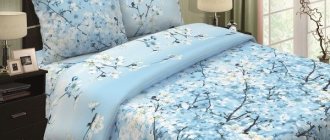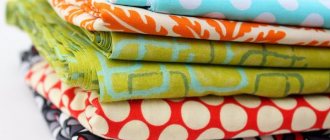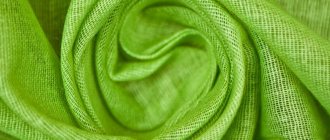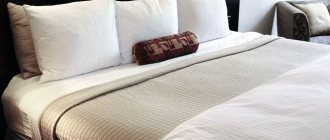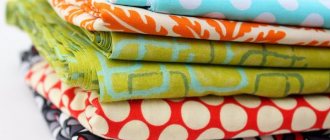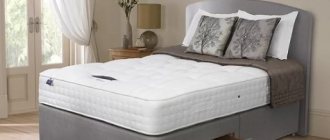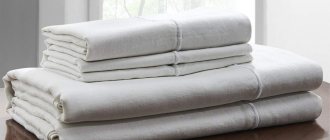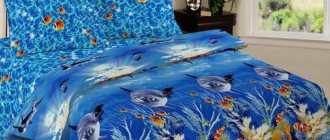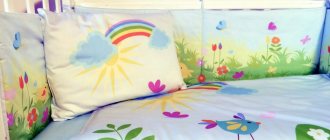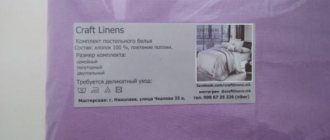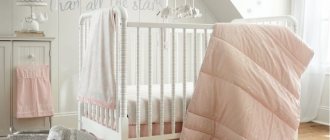Almost every person strives to make their “kingdom of sleep” as comfortable and convenient for relaxation as possible, so when it comes to choosing bedding, preference is given to natural sets. Despite the fact that today there is an incredible selection of synthetic fabrics, preference is still given to those products that have proven their reliability, durability and impeccable performance characteristics over many decades. One of the most popular fabrics from which bed linen is made, and which is chosen by many housewives, is calico bed linen. Why has this material gained immense popularity, and what types of calico exist? Who are these sets suitable for, and which bedding is better - calico or satin? The answers to these and many other questions are of interest to everyone who cares about the quality of their sleep. After reading our information, you will know absolutely everything about this material.
The appearance of calico
This natural material has been known in Rus' since ancient times. It appeared in the Moscow state thanks to merchants who imported calico from Asia back in the 16th century. The name itself is of Arabic origin. With the advent of the 18th century, this linen began to be produced in the Kineshma district and used to create linen for soldiers and caftans. A century later, specialists began to produce various types of calico, which became indispensable in the creation of women's and children's clothing items.
Main characteristics
Calico, what it is and what the material looks like is a question that does not require an answer. Every home definitely has several products made from this type of textile. Calico is a natural material made from cotton. Refers to cotton types of textiles.
What calico looks like and what characteristics are inherent in it:
- The texture is uniform on both sides of the material.
- The width of the canvas can be 1.5 m or 2.2 m.
- The canvas has no shine with a glossy sheen.
- You can recognize the fabric by the cross weave of the threads.
- Completely hypoallergenic, as it contains only natural fibers.
- Easy to care for. The pattern is not washed off during washing. Does not fade in the sun.
The principle of weaving the fabric, which is related to the characteristics of the fabric
. Please note! You can check the quality by looking at the fabric against the light. If there are gaps between the weaves, then the density is low, and therefore the quality is too.
The properties of calico are directly determined by its composition. Mostly they are positive, but there is also a drawback - pellets quickly form on the canvas, which cannot be removed.
You might be interested in Description and composition of cashmere: naturalness of the material, description of the fabric
Why is it better to choose a calico set?
Calico sleeping set is the best choice because the material:
- washes well and does not lose its original appearance. Calico fabric can withstand an incredible number of washes, while maintaining the original size of the bed linen, color shades and patterns;
- very easy to iron, even without steaming;
- excellent air permeability, allowing the skin to breathe;
- absorbs sweat. Calico bed linen, the price of which is affordable for absolutely everyone, is hygroscopic, so it can give comfort even in hot weather;
- does not accumulate static electricity, which is also one of the most important characteristics;
- It has an affordable price, so if you want to buy bed linen inexpensively, then it should be a set of calico fabric.
Selection tips for bedding and clothing
Advice: When choosing products made from calico, you should make sure that the composition of the fabric is absolutely natural. There should be no synthetics at all, or they may be present in minimal quantities. The high content of artificial fibers leads to significant discomfort during sleep, as it creates a “bath” effect and does not allow the skin to “breathe” freely.
The quality of bed linen can be judged by double linen seams and processed edges. The set must be sewn using strong threads that match the color of the fabric.
Bed or clothing made of calico, which smells of paint, mold or “chemicals” is a sign of low quality. It is better to avoid purchasing such products.
Important: If an item can be washed at 60°C or higher, it means that the fabric is dyed with durable dyes that will retain their brightness after repeated washing.
An important element of a good product is the quality of packaging. If the packaging is reliable and attractive, it means that the manufacturer has not skimped on ensuring that its product looks presentable and is protected from environmental factors.
What types of calico are there?
Before choosing a set of bed linen, you should familiarize yourself with the varieties of this material, which is divided into types based on color and density. Today manufacturers offer the following types:
- Fabric "Severe". It is the densest and has a pale cream color. It is used in the creation of workwear, as well as in furniture production.
- Calico "Bleached". This material is somewhat thinner than harsh linen. It is used in sewing workwear and bed linen.
- Material "Plain painted". This type of calico has a structure similar to the previous type of fabric, but in this case the fabric is dyed and takes on a uniform appearance in various colors. The quality of this type of calico allows us to produce excellent bed linen and other products from it.
- Printed fabric. This raw material has a colored pattern and is best suited for creating children's clothing, as well as bed linen. This type of calico can be purchased in our online store - we recommend Euro calico bed linen.
A few words about how calico differs from other materials.
It is worth noting that many people, when buying a set of bed linen (calico), are very disappointed because it does not meet the stated characteristics. This phenomenon is quite understandable. The fact is that, according to established standards, calico is 100% cotton, but in the modern world they began to produce this fabric using synthetic threads. That is why, before making a purchase, read the composition of the material.
So, let's look at how calico differs from other natural fabrics. If you compare this material with:
- chintz, we note that these fabrics have the same weaving technique, but the chintz threads are much thinner. The colors are more durable and colorful in calico;
- satin: thanks to the technique of weaving threads, this material has acquired its shiny surface, which calico does not have. The appearance of satin is similar to silk, and its cost is higher compared to calico fabric. As for the strength of these fabrics, it is problematic to single out a specific option, since everything will depend on the characteristics of the composition and density of these fabrics;
- poplin: it is made using threads of different thicknesses. Initially, this fabric was silk, and calico was completely cotton. Modern poplin is increasingly found with the addition of synthetic fibers, as well as silk and wool threads. It all depends on the brand - manufacturer. The cost of such fabric is higher than the price of calico, while the latter type of fabric is more durable;
- percale: the difference between calico and this material can be seen with the naked eye. Despite the fact that these fabrics have the same weaving techniques, percale looks somewhat thinner and is more delicate to the touch. A sleeping set (calico) will be cheaper than percale bed linen.
To say exactly which bed linen is better, calico or satin, percale, etc. very difficult, because each manufacturer chooses different manufacturing technologies for such bedding.
Reviews
Svetlana Mikhailovna
“In retirement I became interested in sewing toys. For the work, we needed natural, inexpensive, hygroscopic fabric, on which the paint lays in an even layer. I chose white calico and did not regret it. I bring joy to my friends and family with my colorful souvenirs.”
Inna
“The renovated kitchen was crying out for new curtains. The task turned out to be difficult. Prices on the market are off the charts, but the appearance is “nothing special.” It’s good that I caught my eye on a pretty calico with a small flower in the Provence style. With new curtains, the kitchen came to life, bloomed and smelled. They look good and wash well.”
Mayan
“Before buying bed linen, I always run my palm over the surface. I never buy calico for its roughness. Some people like this feature for the possibility of obtaining a massage effect. Even democratic prices don’t attract me. Better expensive, but smooth satin. This is important for my proper sleep and night rest.”
What standards must a sleeping set meet?
The main indicators that calico bed linen must meet are indicated by GOST 29298 2005.
The main characteristic of calico is the density of the fabric. Depending on these indicators, the canvas can be divided into the following categories:
- high density (125 g/m2). This is the best option for bedding sets, since the material has excellent performance and durability;
- average level of density (100 g/m2). Sleeping linen made from this material will also be an excellent choice for home use;
- low density (does not exceed 100 g/m2). This underwear is distinguished by its affordability and reduced wear resistance. With very frequent washing, bed linen will lose its original appearance.
Care
To ensure that a calico product lasts as long as possible, the following care recommendations should be followed:
- It is recommended to wash new products to remove the smell of dyes and remove the impregnation.
- It is advisable to wash items made from calico separately from other fabrics.
- Preference should be given to detergent compositions with universal action.
- When machine washing, set the “cotton” program and temperature from 40 to 60°C.
- Only unpainted products can be boiled and then with caution to prevent shrinkage.
- Colored fabrics should be washed at temperatures up to 45°C.
- Spin at medium or low drum speeds.
- Bedding sets can be dried in the machine.
- Slightly damp items are easier to iron.
- Iron without steam, turning on the “cotton” mode.
- Products made from calico easily starch.
- To avoid shrinkage, wet sheets should be stretched at the corners and dried flat in the fresh air.
By standards, a sheet shrinkage of 10 cm is considered normal: this is 5% in length and 2% in width.
Application for the production of workwear
Most often, the material is used for sewing work coats. In this case, plain-dyed or bleached fabric is used . The use of this material as lining for many types of official clothing: jackets, trousers, suits has become widespread. Previously, all military uniforms were made only from calico.
Anti-allergenicity, lightness, ease of care, durability , long life before discoloration due to washing and fading make calico the main material used for workwear, technical types of suits, gowns, storage covers, and inner parts of shoes.
The best fabric for baby clothes
To organize a child’s sleeping place and ensure maximum comfort during rest, it is necessary to take a responsible approach to the choice of bed linen. It must be of high quality, have a pleasant tactile sensation, meet safety requirements, have the correct size and be liked by the baby.
When choosing a material, you should be guided by the following criteria:
- hypoallergenic - it is better to choose natural fabric, since synthetic fibers can cause an allergic reaction;
- comfort - the fabric should be strong, durable and pleasant to the touch;
- environmentally friendly - there should be no toxic dyes or harmful chemicals;
- air permeability - linen should allow air to pass through well to create a comfortable microclimate;
- ease of care - children's bedding is often washed, so the fabric must withstand numerous washes, retain color and shape.
The most suitable option for children's bedding is cotton. Natural material is relevant in winter and summer, perfectly absorbs excess moisture and creates ideal conditions for a night's rest. The softest material for children's bedding, flannel, is very popular. It has all the advantages of a cotton-based material, is incredibly soft and evokes positive emotions when touched.
Before purchasing the set you like, you should pay attention to the dimensions. For a baby, underwear with dimensions of 110x140 cm for a sheet and duvet cover is suitable, for a pillowcase - 50x40 cm or 50x60 cm. For a schoolchild, you should choose underwear for a single bed - 215x145 cm and 70x70 cm for a pillowcase. Options “for growth” are not desirable because they cause discomfort when used.
From a rich range of colors, you should choose plain options with delicate pastel shades. This color has a calming effect, setting you up for relaxation and sound sleep. Images of popular cartoon and comic characters are allowed. For girls it is worth choosing pink, pistachio, yellow, soft lilac, beige shades, and for boys blue, green, turquoise colors are suitable.
The quality of bed linen for children must be at a high level. The lines are even, without creases or bends, without a pronounced relief texture. For babies, it is recommended to avoid appliqués, inserts, and excessive fringe and braid details.
Photo gallery
Photo No. 1
Photo No. 2
Photo No. 3 Herbarium
Photo No. 4 Children's
Photo No. 5 Arabesque
Photo No. 6 Pavlovian motifs
Photo No. 7
Photo No. 8 Tokyo (Tokyo)
Photo #9 Eva
Photo No. 10 Gerberas
Weave Features
Calico is produced by plain weave. This is the easiest and most durable way to make fabric. The main raw materials for production are cotton threads. The fabric consists of two threads - a lobe and a weft. The share thread is the main thread, and the weft is the auxiliary thread, which is intertwined with the warp. In plain weave, the threads cross in a checkerboard pattern.
The strength of fabric made in this way depends on the density of the weave and the thickness of the fibers. Accordingly, the higher the density of the weave of the threads and their thickness, the more durable and coarse the fabric will be. Despite this, this fabric is much lighter, thinner and stronger than fabrics with a more complex weave. Calico is the only cotton fabric produced this way.
Weaving methods
Fibers of the same linear mass are arranged in different ways in production. As a result, we get a huge variety of materials.
The main weaves used in bed linen:
- plain - the simplest alternation of longitudinal and transverse threads 1:1;
- satin - an arrangement in which the transverse (weft) threads extend to the front side, each of them overlaps 4-5 longitudinal threads (warp).
The most popular plain weave fabrics: calico, its variety ranfors (with a very high density), poplin, chintz. The latter is a very light fabric made of delicate thin fibers. Poplin is made by weaving a thinner warp and a thicker weft, resulting in a fine ribbed pattern and close interlocking of the fibers.
Satin weaving gives the material some looseness, which immediately classifies it as delicate. However, this achieves softness, smoothness, and a silky shine. People with sensitive skin always choose satin bedding.
